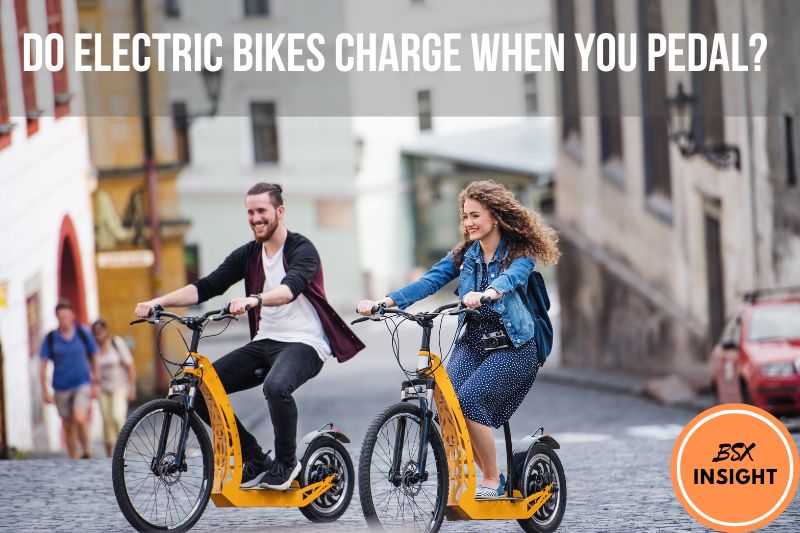Electric bikes have become increasingly popular as an alternative mode of transportation, offering a more eco-friendly and affordable option for commuting or leisurely rides.
However, one question that often arises among electric bike enthusiasts is whether the bike’s battery charges when the rider pedals.
The answer to this question is not a straightforward yes or no, as it depends on several factors, such as the type of electric bike and the specific components it uses.
In this article, BSXInsight will explore the topic in-depth and provide a comprehensive answer to the question, “Do electric bikes charge when you pedal?”
Do Electric Bikes Charge When You Pedal?

The answer to this question is not a straightforward yes or no. It depends on several factors, such as the type of electric bike and its specific components.
Some electric bikes come equipped with regenerative braking systems that can charge the battery when the rider pedals or brakes, while others rely solely on plugging the battery into a power source.
What Is Regenerative Braking for Ebikes?

Regenerative braking is a technology that allows electric bikes to recover energy that would otherwise be lost during braking.
When a rider applies the brakes, the kinetic energy is converted into electrical energy, which is then stored in the bike’s battery. This process is known as regenerative braking.
Regenerative braking is not a new technology. It has been used in hybrid cars for years and has recently been introduced in some electric bikes.
The idea behind regenerative braking is to improve the overall efficiency of the electric bike and extend its range.
How Effective Is Regenerative Braking on an Ebike?

Here is a list summarizing the effectiveness of regenerative braking on an e-bike:
The speed of the bike
The faster the e-bike travels, the more kinetic energy it produces when the brakes are applied. This makes regenerative braking more effective when the rider is traveling at higher speeds.
Terrain
Regenerative braking is most effective when the rider is traveling downhill, as more kinetic energy is produced when the brakes are applied.
When traveling uphill, the rider is expending more energy to pedal, and therefore less energy is being produced through the regenerative braking system.
Style of cycling
Riders who brake frequently and abruptly will produce more kinetic energy through the regenerative braking system than those who brake gradually and less frequently.
Additionally, riders who pedal at a higher cadence will produce more kinetic energy as their legs move faster and generate more power.
Cost and weight
While regenerative braking can be effective, it can also be expensive and add weight to the bike, which can make it less maneuverable and less efficient.
The overall impact on battery life and range
The energy produced through regenerative braking is typically only a fraction of the energy used to power the electric motor, so the overall impact on the battery life and range of the e-bike may not be significant enough to justify the cost and added weight of the regenerative braking system.
Practicality for riders
Regenerative braking is most effective in situations where the rider is traveling at higher speeds and braking frequently.
However, some riders may prefer to ride at a slower pace or on terrain that does not require frequent braking, which can limit the effectiveness of regenerative braking.
Why Is Regenerative Braking So Rare in E-Bikes?

Regenerative braking is a technology that has been around for several decades, but it is still relatively rare in e-bikes. Here are a few reasons why:
Cost
Regenerative braking systems can be expensive to implement, which can drive up the cost of the e-bike.
For manufacturers, this means that they must weigh the benefits of regenerative braking against the cost of implementation and determine whether it makes sense for their target market.
Weight
Regenerative braking systems typically add weight to the e-bike, which can affect its maneuverability and efficiency.
For some riders, the added weight may not be worth the potential benefits of the regenerative braking system.
Efficiency
While regenerative braking can be an effective way to generate power and extend the range of the e-bike, it is not always the most efficient way to do so.
The energy produced through regenerative braking is typically only a fraction of the energy used to power the electric motor, which means that the overall impact on the battery life and range of the e-bike may not be significant enough to justify the cost and added weight of the regenerative braking system.
Market demand
While some riders may value the benefits of regenerative braking, it may not be a top priority for the majority of e-bike buyers.
Manufacturers may focus on other features or technologies that are more in demand rather than investing in regenerative braking systems that may not significantly impact sales.
Regulatory barriers
In some regions, regulatory barriers may exist to implementing regenerative braking systems on e-bikes.
For example, in the European Union, regenerative braking systems must be certified to ensure that they meet safety standards, which can add additional costs and complexity to the manufacturing process.
Despite these challenges, some manufacturers are still investing in regenerative braking technology for e-bikes.
As the industry continues to evolve and demand for more sustainable and efficient transportation options grows, it is possible that we will see more widespread adoption of regenerative braking and other innovative technologies in e-bikes.
FAQs

How far can you ride an electric bike on a single charge?
The range of an electric bike depends on several factors, including the battery’s capacity, the rider’s weight, the terrain, and the speed. Typically, most e-bikes can travel between 20-50 miles (32-80 km) on a single charge, with some models able to travel up to 100 miles (160 km).
How long does it take to charge an electric bike battery?
The charging time for an electric bike battery depends on the battery’s capacity and the charger’s power output. Typically, it takes between 3-6 hours to fully charge an e-bike battery.
Are electric bikes heavy?
Electric bikes can be heavier than traditional bikes due to the added weight of the motor and battery. However, many models are designed to be as light as possible while still providing sufficient power and range.
Can you ride an electric bike in the rain?
Yes, most electric bikes are designed to be weather-resistant and can be ridden in the rain. However, you should take care to avoid getting the battery and electrical components wet, as this can damage them.
Conclusion
In conclusion, whether an electric bike can charge when you pedal depends on its specific design and components.
Some electric bikes do come equipped with regenerative braking systems that can charge the battery when the rider pedals or brakes, while others rely solely on plugging the battery into a power source.
Ultimately, suppose you want to maximize the battery life of your electric bike. In that case, it is crucial to choose a model that is designed with a regenerative braking system or to ride your bike in a way that conserves battery life.
Whatever the case may be, electric bikes are a great way to enjoy the benefits of cycling while minimizing your environmental impact and saving money on transportation costs.

